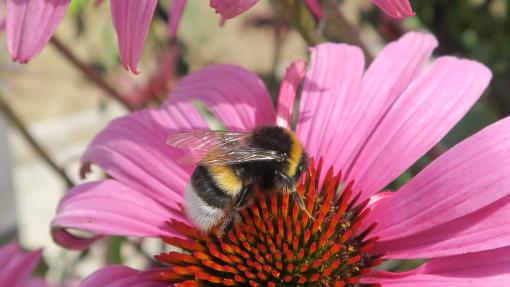Bumblebees are bees and are one of nature's most important pollinators. There are at least 35 species in Slovenia and at least 45 species in Italy. The easiest way to distinguish them is by their different colour combinations. Like honeybees, bumblebees live in colonies, but their colonies are much smaller. They range from a few 10 to a few 100 individuals, depending on the species. Colonies are short-lived, which means that they form in spring and die in autumn. Only the last queen of the last year of the brood survives the winter.
The queens become active in spring, at the first strong thaw. They are first seen feeding on the first flowering plants, such as willow, crocus or lungwort. This is also when they look for a suitable nesting site.
Bumblebees nest underground in abandoned nests of small mammals or on the ground surface in moss or grass. Some species also make their homes in duplexes, firewood stacks, attics, insulation, etc. The queen makes a pot in the nest to store the honey she has collected and a wax cluster where she hatches her eggs. The eggs hatch into larvae, which the queen takes care of by feeding and keeping warm. Over time, the larvae develop into the first workers, who take over the collection of the honey and the care of the brood. Over the summer, the number of workers increases. At the peak of the colony's development, new queens and males develop. The males leave the nest on their own. They live outdoors for a while, foraging for food and roosting on flowers, and mating with the new queens. The young queens leave the nest to mate. They then need to eat and build up enough fat reserves to overwinter. They overwinter in the ground, in arid areas, so that winter thaws do not frighten them too quickly. A nest with an old queen will collapse in autumn at the latest.
Bumblebees are excellent pollinators. This is made possible by their compact body, speed, long tongue and other pollination methods, such as shaking the flowers. They are also active from early morning to late evening. They are also undisturbed by bad weather. They also pollinate in cold, rain and wind. Bumblebees are essential in food production. They are often used in greenhouses to pollinate tomatoes and peppers, as they are more efficient than bees at this. However, their numbers are declining, due to factors such as lack of food and suitable nesting sites, and improper use of pesticides. As individuals, there is much we can do to save bumblebees. By protecting colourful and flowering meadows and borders, we can give them enough food and nesting places. We can also provide them with food by sowing honey plants.
Prepared by the National Institute of Biology
Photo from Danilo Bevk

